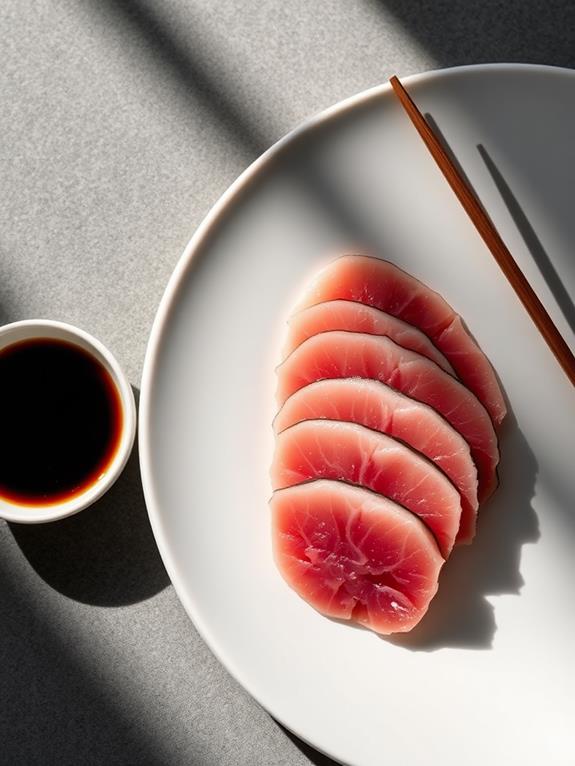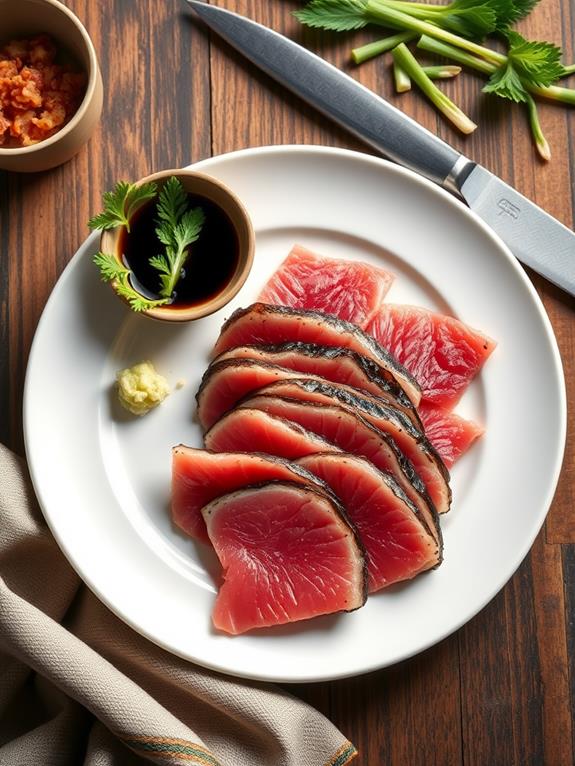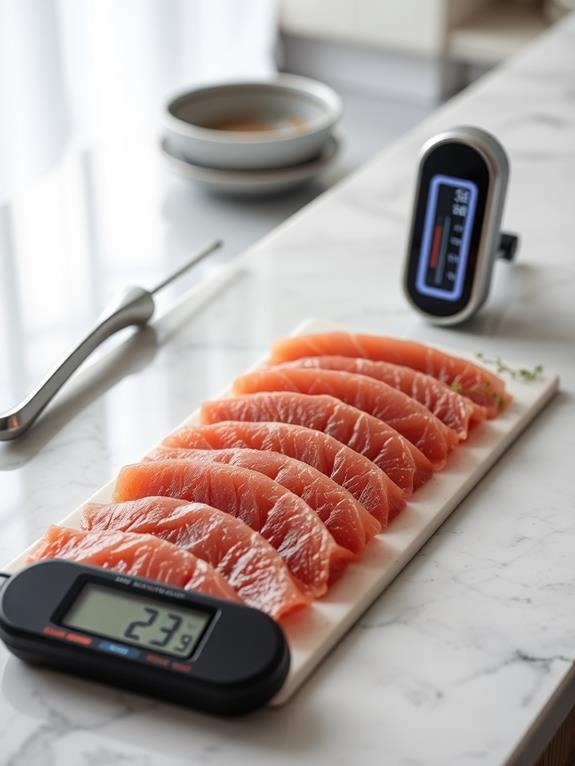Is It Safe to Eat Tuna Raw
Raw tuna can be safe to eat when handled properly, but it comes with risks you should consider. While it's a nutritious, low-calorie protein source rich in omega-3s, raw tuna may contain parasites or bacteria that can cause illness. To minimize risks, choose "sushi-grade" tuna from reputable sources and verify it's been frozen at -4°F for at least seven days. Be aware of mercury levels, especially in larger tuna species, and limit your intake accordingly. Pregnant women, young children, and those with compromised immune systems should be particularly cautious. Proper selection, handling, and preparation are essential for enjoying raw tuna safely. Understanding these factors can help you make informed decisions about consuming this popular delicacy.
This post may contain affiliate links. If you make a purchase through these links, I may earn a commission at no additional cost to you. Additionally, portions of this post may be generated using artificial intelligence (AI) technology. While we strive for accuracy, please be aware that AI-generated content may not always be perfect and should be fact-checked when necessary.
The Spatula Scoops
- Raw tuna can be safe when properly sourced, handled, and prepared, but carries risks of parasites and foodborne illnesses.
- Freezing tuna at -4°F for at least 7 days helps eliminate parasites and enhance safety for raw consumption.
- Mercury contamination is a concern, especially in larger tuna species, requiring moderated consumption for health safety.
- Pregnant women, young children, and vulnerable groups should exercise caution or avoid consuming raw tuna.
- Selecting "sushi-grade" tuna from reputable sources and following strict sanitation practices can minimize health risks.
Understanding Raw Tuna Consumption

Raw tuna consumption has become increasingly popular, especially in dishes like sushi and sashimi. If you're considering eating raw tuna, it's critical to understand the potential risks and necessary precautions. While tuna is generally considered safer than other fish for raw consumption, it's not without its hazards. Properly sourced and handled tuna can offer health benefits, including omega-3 fatty acids, similar to those found in salmon skin, which markedly reduce heart disease risk and help lower blood pressure (omega-3 fatty acids benefits).
One of the primary concerns with raw tuna is the presence of parasites, particularly Anisakis. These parasites can cause foodborne illnesses if ingested. To mitigate this risk, health authorities recommend freezing raw tuna at -4°F for at least seven days before consumption. This process effectively kills any parasites that might be present in the fish.
When selecting raw tuna, it's vital to source it from reputable fish markets and guarantee proper handling and preparation techniques are followed. Popular varieties for raw consumption include yellowfin, albacore, and bluefin tuna. However, be aware that these species may contain mercury, so moderation is advised, especially for pregnant women.
While the incidence of foodborne illness from raw tuna is relatively low, it's important to remain vigilant. Proper sourcing, handling, and preparation are key to minimizing risks and enjoying raw tuna safely.
Health Benefits of Raw Tuna

Seafood enthusiasts often praise the nutritional powerhouse that is raw tuna. When you consume raw tuna, you're getting a lean protein source that's packed with essential nutrients. It's an excellent choice for muscle maintenance and repair, providing over 20 grams of protein per 3-ounce serving in some varieties. The health benefits of raw tuna extend beyond just protein, though. Just like raw corn can offer a variety of health advantages, raw tuna also provides essential omega-3 fatty acids that contribute greatly to heart and brain health.
Raw tuna is rich in omega-3 fatty acids, which are vital for heart and brain health. You'll also find important vitamins and minerals like B12, vitamin D, iron, and selenium. These nutrients support various bodily functions and boost your immune system. If you're watching your calorie intake, raw tuna is a great option, with only about 70 calories per 2-ounce serving of albacore.
Here are some key benefits of consuming raw tuna:
- High-quality protein for muscle health
- Omega-3 fatty acids for heart and brain function
- Essential vitamins and minerals for overall well-being
- Low-calorie option for weight management
- Fresh, high-quality culinary experience
Potential Risks and Concerns

When considering raw tuna consumption, you'll need to be aware of potential parasites and foodborne illnesses. These risks include Anisakis and Kudoa hexapunctata parasites, as well as bacterial contamination from pathogens like Salmonella and Vibrio, which can lead to unpleasant symptoms such as diarrhea, vomiting, and fever. Additionally, you should be concerned about mercury contamination, particularly in larger tuna species like albacore, yellowfin, and bluefin, which often exceed recommended consumption limits and can pose health risks, especially for vulnerable groups like pregnant women and young children. For those who enjoy cooking with fish, it's important to guarantee proper preparation techniques, similar to how quality bakeware like the USA Pan Bakeware can enhance food safety and cooking outcomes.
Parasites and Foodborne Illnesses
Consuming raw tuna isn't without its risks, particularly when it comes to parasites and foodborne illnesses. You should be aware that raw tuna can harbor parasites like Anisakis and Opisthorchiidae, which may cause gastrointestinal infections. These parasites are more common than you might think, with studies showing infection rates as high as 64% in young Pacific bluefin tuna from Japan.
Bacterial contamination is another concern. Pathogens such as Salmonella and Vibrio can thrive on improperly handled raw fish, potentially leading to foodborne illness. While the risk of infection from eating sushi is relatively low (less than 0.8% of restaurant patrons report issues), the consequences can be severe for those affected.
To lessen these risks, the FDA recommends freezing tuna at -4°F for at least 7 days before consumption. This process helps eliminate parasites and enhances food safety. When consuming raw tuna, consider the following:
- Choose reputable sources for your fish
- Guarantee proper handling and storage
- Be cautious when preparing raw tuna at home
- Pay attention to any recall notices
- Consult your doctor if you experience symptoms after consumption
Mercury Contamination Concerns
Beyond parasites and bacterial contamination, mercury levels in raw tuna present a significant concern. When you consume raw seafood, especially tuna, you're exposing yourself to potentially high mercury concentrations. Various tuna species, including albacore, yellowfin, bluefin, and bigeye, have been found to contain mercury levels exceeding recommended limits in raw sushi samples.
This is particularly worrisome for pregnant women and young children, who are more vulnerable to mercury's effects. Health guidelines suggest limiting tuna consumption to no more than 160 grams per week for these groups. If you're eating raw tuna frequently, you're at risk of mercury accumulation in your body, which can lead to brain and heart damage over time.
It's important to note that mercury levels vary among tuna species, with larger fish generally containing higher concentrations. Additionally, the fatty toro part of the tuna, often prized in sushi, contains high levels of dioxins, further compounding potential health risks. When considering raw tuna consumption, be aware of these mercury contamination concerns and make informed decisions about your seafood intake.
Proper Selection of Raw Tuna

The proper selection of raw tuna is essential for guaranteeing both safety and quality when enjoying this popular fish uncooked. When you're at the fish market, always look for tuna labeled as "sushi-grade." This designation indicates that the fish has been handled and processed according to strict standards, making it safer for raw consumption. Additionally, similar to the benefits of plant-based milk alternatives, fresh tuna can provide a rich source of omega-3 fatty acids, which are important for heart health.
To further guarantee your safety, keep these key points in mind:
- Choose tuna with a bright, deep red color
- Verify that the fish has been frozen for at least 7 days at -4°F
- Check for a clean, ocean-like smell
- Avoid any fish with discoloration or off odors
- Select tuna from reputable sources or certified seafood programs
Safe Preparation Techniques

Once you've selected the right tuna, it's time to focus on safe preparation techniques. To guarantee your raw tuna is safe to eat, you'll need to freeze it at -4°F for at least seven days. This important step, recommended by the FDA, effectively kills any parasites that might be present in the fish. Additionally, utilizing accurate measurements can assist in preparing sauces and accompaniments that complement your dish, similar to how the OXO Good Grips 5-lb Food Scale provides precise ingredient combinations.
When you're ready to prepare your sushi-grade tuna, maintain strict sanitation practices. Clean all surfaces and utensils thoroughly, and avoid cross-contamination with other foods. Remember to store your raw tuna below 40°F until you're ready to use it.
As you prepare the tuna, use proper techniques like quick killing methods and thorough gutting to minimize contamination risks. These steps are vital for enhancing the safety of your raw tuna dish.
Once you've prepared your tuna, consume it immediately to maintain its freshness and prevent spoilage. By following these safe preparation techniques, you'll greatly reduce the risk of foodborne illness and confirm that your raw tuna experience is both delicious and safe.
Cultural Significance of Raw Tuna

You'll find that sushi's global influence has transformed raw tuna from a regional delicacy into an international culinary phenomenon. This shift in perception parallels the versatility showcased in various cooking methods, such as the Breville Smart Oven Air Fryer Pro, which allows for innovative ways to prepare a variety of dishes. As this dish has spread worldwide, you've likely noticed how culinary traditions have evolved, incorporating local flavors and presentation styles into raw tuna preparations. This cultural exchange has not only broadened the appeal of raw tuna but has also led to innovative fusion dishes that blend traditional techniques with contemporary tastes, showcasing the adaptability of this iconic ingredient.
Sushi's Global Influence
Raw tuna's journey from traditional Japanese cuisine to global culinary sensation has been nothing short of remarkable. You'll find that sushi, with its emphasis on raw fish, particularly tuna, has notably influenced global cuisine. This impact has led to the widespread popularity of raw fish dishes across diverse culinary landscapes. The growing acceptance of raw tuna is evident in the projected 71% increase in demand for poke bowls in North America by 2026.
Sushi's global influence has:
- Transformed raw tuna into a celebrated delicacy
- Inspired culinary innovations and new raw fish dishes
- Elevated the status of sushi chefs as skilled artisans
- Increased awareness of fish quality and sourcing
- Sparked fusion cuisine incorporating raw fish elements
The cultural traditions surrounding sushi have played a key role in shaping global perceptions of raw fish consumption. These traditions emphasize the importance of quality and freshness, with meticulous sourcing and preparation techniques. As a result, you'll find that raw tuna has become not just a food item, but a symbol of culinary artistry. This global interest in sushi has spurred adaptations that honor traditional practices while appealing to contemporary palates.
Culinary Traditions Evolve
As sushi's global influence continues to expand, culinary traditions surrounding raw tuna are evolving in fascinating ways. You'll find that raw tuna dishes are no longer confined to traditional sushi restaurants. Innovative chefs are incorporating this delicacy into various cuisines, creating fusion dishes that blend cultural flavors and techniques.
| Traditional | Modern Twist |
|---|---|
| Nigiri | Poke Bowls |
| Sashimi | Tuna Tartare |
| Maki Rolls | Sushi Burritos |
The art of preparing raw tuna has also evolved. While Japanese chefs have long perfected the technique of slicing Bluefin tuna, you'll now see chefs worldwide adopting and adapting these methods. They're combining traditional skills with modern presentation styles, often using garnishes and sauces that complement the tuna's natural flavor.
This evolution isn't just about taste; it's also about experience. Raw tuna dishes are increasingly becoming centerpieces for social dining. You'll find that sharing these dishes fosters a sense of community, much like in traditional Japanese culture. As culinary traditions evolve, they're not just changing how we eat raw tuna, but also how we connect over food.
Nutritional Profile of Raw Tuna

The nutritional profile of raw tuna makes it a standout choice for health-conscious eaters. When you're looking to incorporate raw fish into your diet, Yellowfin tuna offers an impressive array of benefits. With just 70 calories per 3-ounce serving, it's a low-calorie option that's packed with protein, often exceeding 20 grams. This makes it an excellent choice for muscle growth and repair. Additionally, the sustainability concerns surrounding fish sources highlight the importance of responsible sourcing to guarantee environmentally friendly practices that protect marine ecosystems.
Raw tuna isn't just about protein, though. It's also rich in:
- Omega-3 fatty acids for heart and brain health
- Vitamin B12 and vitamin D for overall well-being
- Iron and potassium for essential bodily functions
- Selenium, a powerful antioxidant
- Minimal carbohydrates, ideal for low-carb diets
You'll find that different types of tuna offer varying nutritional profiles. Fattier cuts like toro provide more flavor and beneficial fatty acids compared to leaner options. When you're selecting raw tuna, consider your specific nutritional needs. Whether you're aiming for muscle gain, heart health, or simply a delicious low-calorie meal, raw tuna can be an excellent addition to your diet. Just remember to source it from reputable suppliers to guarantee safety and quality.
Mercury Levels in Raw Tuna

You should be aware of the mercury levels in raw tuna, as they can pose significant health risks. Larger tuna species like albacore, yellowfin, bluefin, and bigeye tend to accumulate higher levels of mercury, which can lead to brain and heart damage with regular consumption. Properly considering your tuna choices, especially with regard to oatmeal safety practices, is important for overall health. To protect yourself, especially if you're pregnant, it's vital to follow consumption recommendations and limits set by health authorities, which may vary depending on the specific type of tuna you're eating.
Health Risks of Mercury
Consuming raw tuna comes with a notable health concern: mercury exposure. This heavy metal accumulates in tuna's tissues over time, particularly in larger species like albacore, yellowfin, bluefin, and bigeye. When you eat raw tuna, you're potentially ingesting higher levels of mercury than you would with cooked fish. Studies show that the average mercury concentration in raw sushi tuna often exceeds recommended safe limits.
The health risks associated with excessive mercury consumption are significant:
- Neurological damage
- Adverse effects on heart health
- Developmental issues in fetuses and young children
- Impaired cognitive function
- Increased risk of cardiovascular disease
It's essential to be aware of these risks, especially if you're pregnant or have young children. While mercury poisoning isn't the same as bacterial food poisoning, it can have long-lasting impacts on your health. To minimize your risk, limit your intake of raw tuna, particularly if you're in a high-risk group. Guidelines suggest consuming no more than 160 grams of tuna weekly for pregnant women and children. Remember, certain tuna types like yellowfin and albacore have fewer restrictions, but it's still wise to moderate your consumption.
Types With Highest Levels
Diving into the world of raw tuna, it's vital to understand which types carry the highest mercury levels. When it comes to raw consumption, larger tuna species pose the greatest risk. Bluefin and bigeye tuna top the list, containing the highest concentrations of mercury. These types of fish are often used in high-end sushi and sashimi dishes, but their mercury content makes them a riskier choice for raw consumption.
Albacore tuna isn't far behind, with mercury levels frequently exceeding 0.4 parts per million (ppm). This puts it in the higher risk category as well. Studies have shown that mercury levels in raw tuna sushi samples often surpass recommended consumption limits, which is cause for concern.
While yellowfin tuna may have lower mercury levels compared to its larger counterparts, it's still important to practice moderation. The potential for mercury accumulation in your body means you shouldn't overindulge, even with these relatively safer options. If you're pregnant, it's vital to limit your intake of high-mercury tuna varieties to no more than 160 grams per week to protect your health and your baby's development.
Consumption Recommendations and Limits
Raw tuna consumption often comes with a delicate balancing act between culinary enjoyment and health risks. Health authorities have established consumption recommendations to help you navigate these waters safely. Due to the high levels of mercury found in certain tuna species, it's vital to limit your intake. For the general adult population, experts suggest consuming no more than 3-5 ounces of raw tuna per week. If you're pregnant, you'll need to be even more cautious, limiting your intake to 160 grams (about 5.6 ounces) of lower mercury fish weekly while avoiding high-mercury tuna altogether.
Here's what you need to keep in mind:
- Albacore, yellowfin, and bluefin tuna tend to have higher mercury levels
- Regular consumption of high-mercury fish can lead to brain and heart damage
- Pregnant women and young children are particularly vulnerable to mercury risks
- Studies show that many raw sushi tuna samples exceed safe mercury limits
- Moderation is key when enjoying raw tuna to minimize health risks
Regulatory Guidelines for Raw Fish

The regulatory landscape for raw fish consumption in the United States is somewhat murky. Unlike other food products, there's no official body overseeing the labeling of "sushi-grade" fish. This lack of standardization means you'll find varying quality and safety standards across different fish markets. Choosing the right preparation tools can enhance your raw fish experience, much like selecting quality cookware can notably improve your cooking outcomes. The T-fal 2-Piece Hard Anodized Nonstick Fry Pan Set demonstrates how superior kitchen tools can make meal preparation safer and more efficient.
When it comes to regulatory guidelines for raw fish, the FDA recommends freezing fish at -4°F for at least a week to kill parasites. This process is critical for your safety, but it's not always enforced. That's why it's imperative to buy from reputable sources that have established their own sushi-grade fish standards. These sellers often go above and beyond to guarantee their products are safe for raw consumption.
Local health regulations play a significant role in maintaining food safety. They often set requirements for restaurants and markets serving raw fish. Regular inspections and strict adherence to sanitation guidelines are essential in minimizing risks associated with consuming raw fish. As a consumer, you should be aware that while there are guidelines in place, the onus is often on you to choose trustworthy sources for your raw fish needs.
Alternatives to Raw Tuna Consumption

Fish lovers seeking to enjoy tuna's flavors without the risks associated with raw consumption have numerous alternatives at their disposal. Cooked fish options like salmon, cod, and crab offer safer choices, especially for pregnant women and children, due to their lower mercury content. You can also try marinated fish dishes like ceviche, where acidic ingredients 'cook' the fish, reducing parasite risks while maintaining a fresh taste. For those who appreciate elegant kitchen tools, a polished marble rolling pin can enhance your food preparation experience in various ways, promoting an effortless role in cooking and baking elegant design and features.
For a more traditional approach, you might consider grilling, baking, or steaming your fish. These methods not only enhance flavor and texture but also provide a safer eating experience. If you're looking for convenience, canned tuna is an excellent option that retains many of tuna's nutritional benefits without the risks of raw consumption.
For sushi lovers, plant-based or seafood alternatives can satisfy your cravings. Consider trying:
- Avocado rolls
- Imitation crab rolls
- Cucumber rolls
- Cooked shrimp rolls
- Vegetable tempura rolls
Frequently Asked Questions
Is It OK to Eat Raw Tuna in Sushi?
Yes, it's generally safe to eat raw tuna in sushi if you follow certain precautions. You should choose sushi-grade tuna from reputable suppliers who've properly frozen and handled the fish. Remember, freezing for at least 7 days at -4°F kills potential parasites. While eating raw tuna carries some risks, proper preparation minimizes them. Be mindful of your intake due to mercury concerns, limiting consumption to 3-5 oz, 2-3 times per week. Always prioritize restaurants with good hygiene practices for the safest experience.
Can I Eat Raw Tuna From the Grocery Store?
You shouldn't eat raw tuna from the grocery store without taking precautions. Unless it's labeled as sushi-grade, it may contain parasites or bacteria. To reduce risks, freeze the tuna at -4°F for at least 7 days before consuming. Grocery stores often can't guarantee the fish's freshness or cleanliness, increasing the chance of foodborne illnesses. It's safer to eat raw tuna at reputable sushi restaurants, where they follow strict sanitary practices. Always check local health guidelines before eating raw fish from stores.
What Kind of Tuna Can You Eat Raw?
You can safely eat several types of tuna raw. Yellowfin, bluefin, and bigeye tuna are commonly consumed raw due to their lower parasite risk. Look for "sushi-grade" labels, though they're not officially regulated. These varieties are often flash-frozen at sea, which helps eliminate parasites. Remember, larger species like albacore and bluefin may have higher mercury levels, so consume them in moderation. Always purchase raw tuna from reputable sources that follow proper safety protocols to guarantee freshness and quality.
Is It Safe to Eat Canned Tuna Raw?
Did you know that over 1 billion cans of tuna are consumed annually in the US alone? It's safe to eat canned tuna "raw" because it's already cooked during the canning process. You don't need to heat it further. However, always check the expiration date and can integrity before consuming. While it's pre-cooked, it's still important to handle it safely. Refrigerate opened cans and consume within a few days. Remember, moderation is key due to potential mercury content, especially in larger tuna species.





